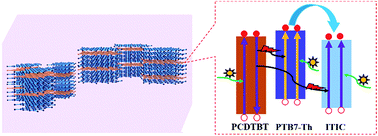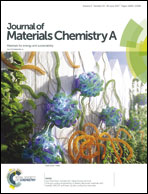Dual Förster resonance energy transfer effects in non-fullerene ternary organic solar cells with the third component embedded in the donor and acceptor†
Abstract
Non-fullerene ternary organic solar cells (OSCs) are new promising candidates for future applications in the area of organic photovoltaics. However, their low short-circuit current (JSC) values impede efforts at increasing their power conversion efficiency (PCE) levels. Maximizing the JSC is one of the critical elements for enabling high performances of OSCs. To improve the JSC of the non-fullerene ternary OSCs based on poly[[2,6′-4,8-di(5-ethylhexylthienyl)benzo[1,2-b:3,3-b]dithiophene][3-fluoro-2[(2-ethylhexyl)carbonyl]thieno[3,4-b]thiophenediyl]]:3,9-bis(2-methylene-(3-(1,1-dicyanomethylene)-indanone))-5,5,11,11-tetrakis(4-hexylphenyl)-dithieno[2,3-d:2′,3′-d′]-s-indaceno[1,2-b:5,6-b′]-dithiophene (PTB7-Th:ITIC), a polymer of poly[N-9′′-hepta-decanyl-2,7-carbazole-alt-5,5-(4′,7′-di-2-thienyl-2′,1′,3′-benzothiadiazole)] (PCDTBT) was added to the binary system. The PCDTBT was shown to embed in both PTB7-Th and ITIC, and introduced dual Förster resonance energy transfer (FRET) effects in the resulting ternary system. In addition, the PCDTBT may have decreased the molecular coherence lengths of PTB7-Th and ITIC and influenced the charge transport. Furthermore, the PCDTBT apparently also decreased the d-spacing of the π–π stacking of PTB7-Th and ITIC, which likely increased the intermolecular charge hopping efficiency. Doping an appropriate amount of PCDTBT in the system yielded an increase in the JSC from 13.89 to 16.71 mA cm−2. The increased JSC resulted in a 15% enhancement of the PCE, which indicated that introducing dual FRET effects is an effective way to enhance the JSC and thus the performance of the OSCs.



 Please wait while we load your content...
Please wait while we load your content...